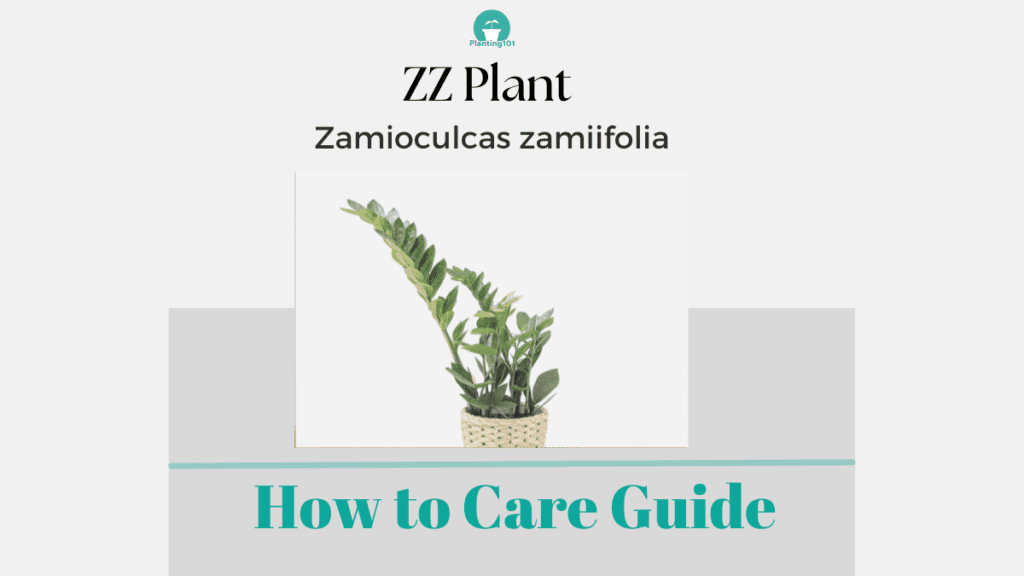ZZ Plant (Zamioculcas zamiifolia) or Zanzibar Gem is a hardy, low maintenance, and easy to grow houseplant. It is coveted for its glossy, thick, fern-like leaves. Here are some pointers on how to take care of your ZZ plant.
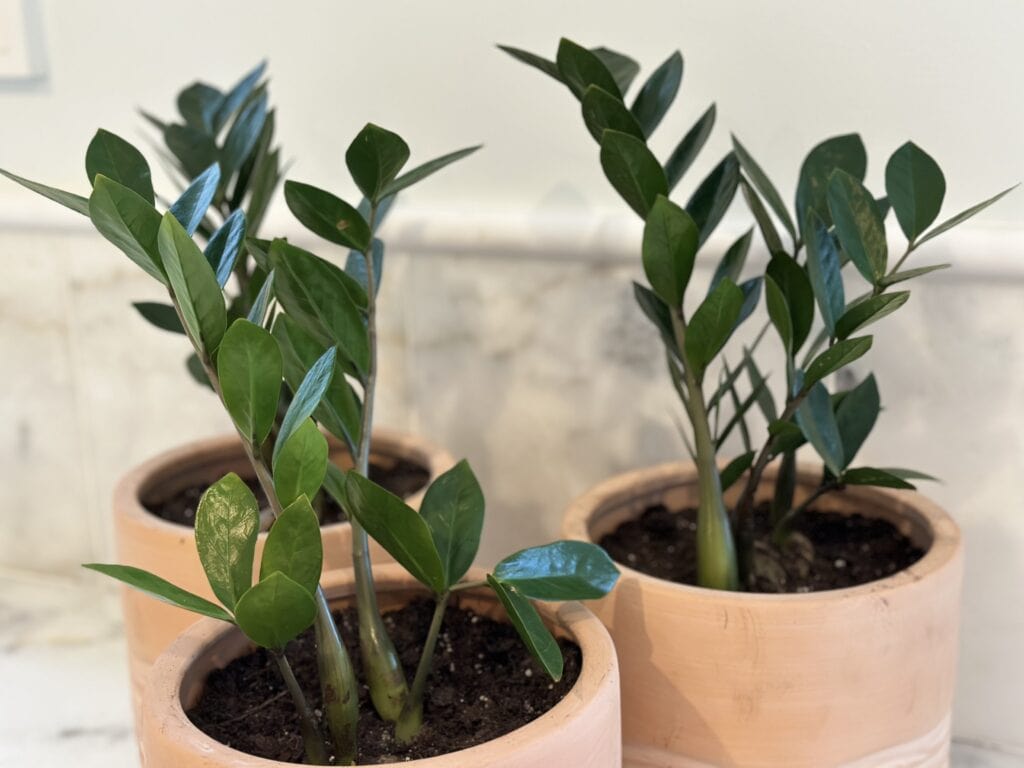
ZZ Plant Basics (Zanzibar Gem)
| Name | ZZ Plant |
| Scientific Name | Zamioculcas zamiifolia |
| Light | Bright, filtered Light but can tolerate low light |
| Daytime Temperature | 70 to 80 F (21-26C) |
| Night Time Temperature | 60 to 70 F (15-21C) |
| Water | Moderate Water |
| Humidity | Tolerates dry air well |
| Potting | Well-draining, organic, cactus potting mix |
| Fertilizer | Once every 3 weeks at half-strength |
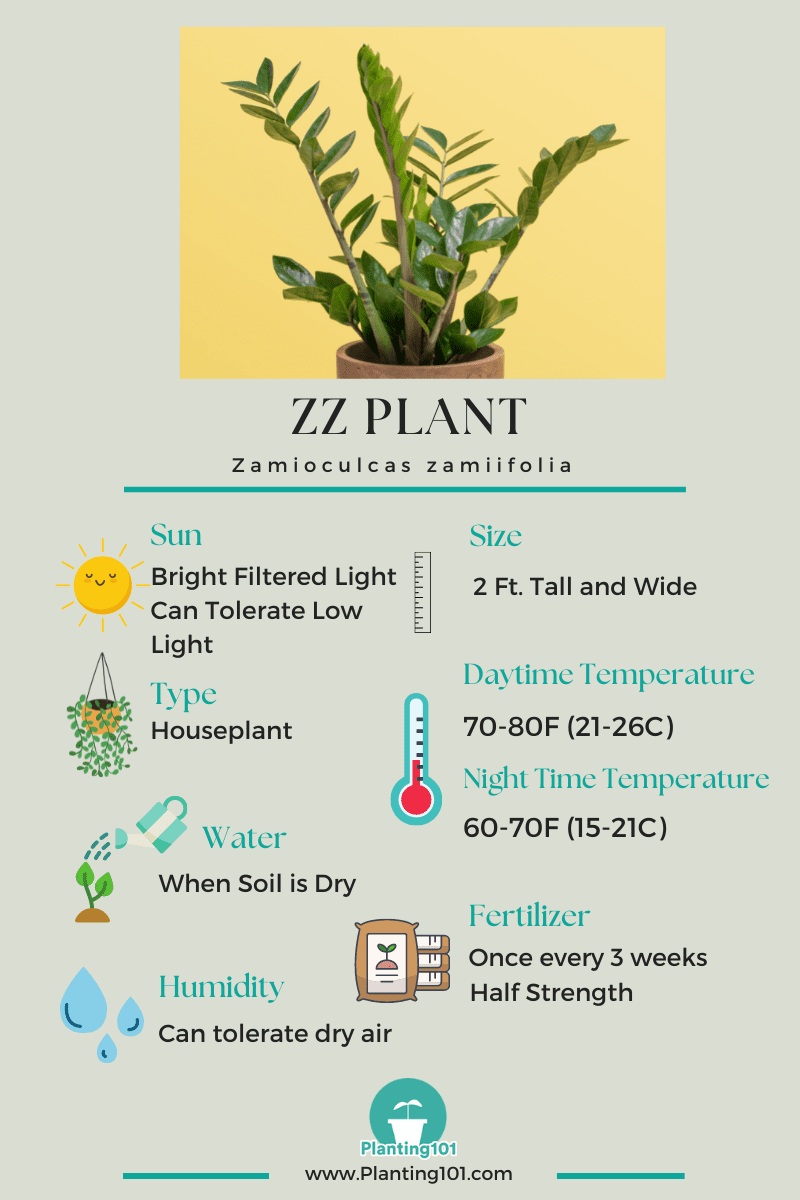
ZZ Plant: Other Names
ZZ Plant is also called Zanzibar Gem, Aroid Palm, Fat Boy, and Eternity Plant.
ZZ Plant: Size
ZZ Plant can grow to 2 feet tall and 2 feet wide.
ZZ Plant: Toxic to Pets?
ZZ Plants are toxic to humans and pets. The leaves can cause vomiting and difficulty breathing. It can also result in swelling of lips, tongue, and mouth and excessive drooling. Don’t let children or pets chew on the leaves of the ZZ plant because it contains calcium oxalate crystals.
If you see any of these symptoms and suspect ingestion of ZZ plant, call poison control immediately! Also, call your doctor or vet once you start seeing adverse reactions in children and pets.
Light
ZZ Plant: Sun or Shade?
ZZ Plant will grow best in bright, filtered light but can tolerate low light from a North window. It grows better in brighter light. It does not like direct sunlight though, the leaves will burn.
Water
How Often Should You Water Your ZZ Plant?
The key to success with ZZ plants is to only water them when the soil feels dry. The best way to determine when it is time to water your ZZ plant is to feel the soil. Stick your finger in the soil 2 inches deep. If the soil feels dry, it’s time to water your Zanzibar Gem. If the soil is wet, then don’t water your Zanzibar Gem. If it’s kept at low light, allow the soil to dry all the way to the bottom before watering.
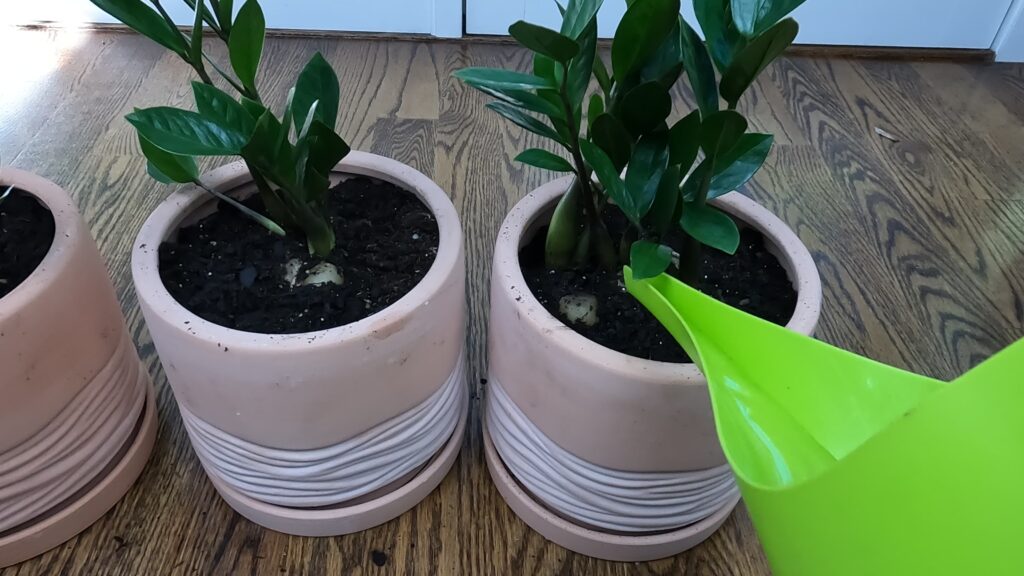
The frequency of watering will be dependent on the type of pot you have your ZZ plant in. Unglazed pots like terracotta are porous and will dry up more quickly than if you have your ZZ plant planted in plastic, metal or glazed ceramic pots. These pots don’t breathe so will retain moisture much longer. The environment will also affect how often you water your Zanzibar Gem. Hot summer days will require more watering (even if your ZZ plant is indoors) while cold, winter days will require less watering.
I typically water my ZZ plants once every 2-3 weeks. If you are unsure, it’s better to underwater than to overwater your ZZ plant.
What Type of Water Should You Use When Watering Your ZZ Plant?
You can water your Zanzibar Gem with tap water, but keep in mind the temperature of the water. The ZZ plant prefers cool, not hot or cold, water. Add a little warm water to the cold water when you turn on the faucet. Fill a watering can or pitcher completely with water and let it out overnight until the water is at room temperature.
How Do You Make Sure There is Proper Drainage for Your ZZ Plant?
If you water your ZZ plant and notice water leaking from the drainage holes in the pot, make sure you empty the water that has gathered in the saucer. Do not let the pot of your Zanzibar Gem sit in this puddle of water. It will result in root rot!
Do You Need to Mist Your ZZ Plant?
No, you don’t need to mist your ZZ Plant. Your ZZ Plant is a plant that tolerates dry air well.
Do You Need to Wipe the Leaves of Your ZZ Plant?
No, you don’t need to wipe the leaves of your ZZ plant. Although, if you see a lot of dust accumulation, it’s not a bad idea to wipe the leaves of your ZZ plant.
Soil
What Type of Potting Mix is Best for Your ZZ Plant?
Your ZZ Plant needs a well-draining, organic cactus potting mix. You can make your own cactus potting mix for your ZZ Plant (see below).
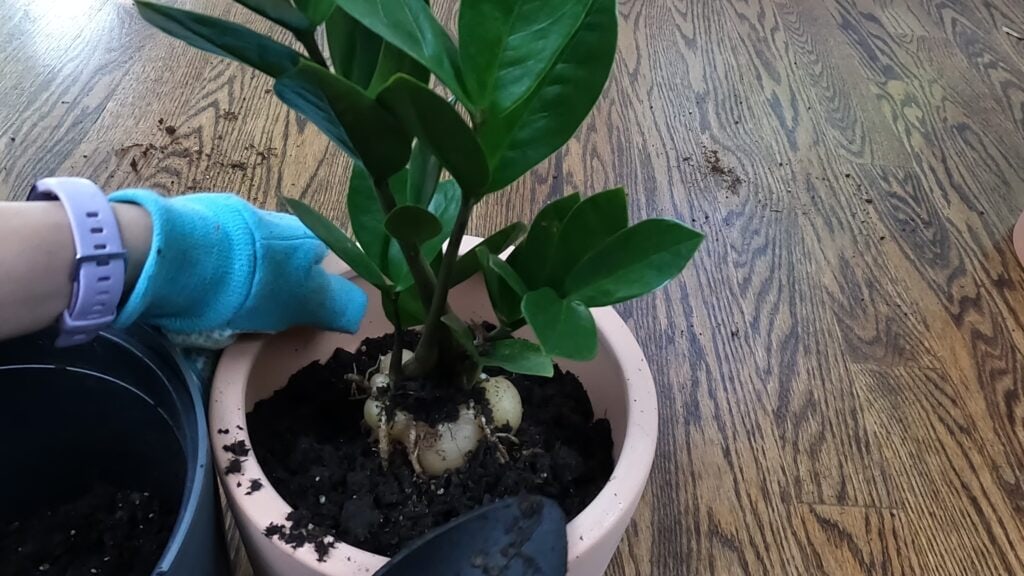
How to Make ZZ Plant Potting Mix
You can make your own potting mix for your ZZ Plant by blending the following potting media:
1 Part Sand
3 Parts All-Purpose, Organic Potting mix
How Do You Know When To Repot Your ZZ Plant?
When your ZZ plant outgrows its present pot, repot it. Repot in a container that is 2 inches wider in diameter than the existing one.
Check out my post on how I repotted my ZZ plant.
Fertilizer
Do You Need to Fertilize Your ZZ Plant?
Fertilize your ZZ Plant once every three months at half strength.
What Fertilizer Should You Use on Your ZZ Plant?
On your ZZ Plant, use organic fertilizers with a higher nitrogen ratio.
Propagation
How Do You Propagate Your ZZ Plant?
Your ZZ Plant is easy to propagate. You can propagate the ZZ plant by division or leaf cuttings.
How to Propagate ZZ Plant
Below are steps on how to propagate ZZ plant by leaf cuttings.
1. Take a Stem Cutting of ZZ plant (include a node)
Pick a stem with a node. Cut below the node.
2. Place ZZ plant Stem in a Jar of Water
Wait for the ZZ plant stem to sprout roots in a jar of water. Make sure your stem has no more than 2 leaves to assist it focus its efforts on establishing roots. As needed, remove excess leaves.
As an alternative, you can also stimulate root growth by dipping your stem cutting in root hormone, and planting it in moist sand. I personally prefer the jar method since the roots are visible.
Because not every ZZ plant stem cuttings will establish roots, cut a few stem cuttings to ensure you receive at least one with roots.
3. Plant Stem Cutting in New Pot
Plant these stem cuttings in a new pot once the roots have grown. Water the new plant as soon as possible after it is planted. After that, water every 2-3 days until the roots have established themselves.
4. Place New ZZ plant in a Location with Bright Indirect Sun
Place your new ZZ plant in a location that receives plenty of bright indirect sunlight. Avoid exposing it to direct sunlight.
Check out my post on how I divided my ZZ plant. I divided one ZZ plant into 3 plants!
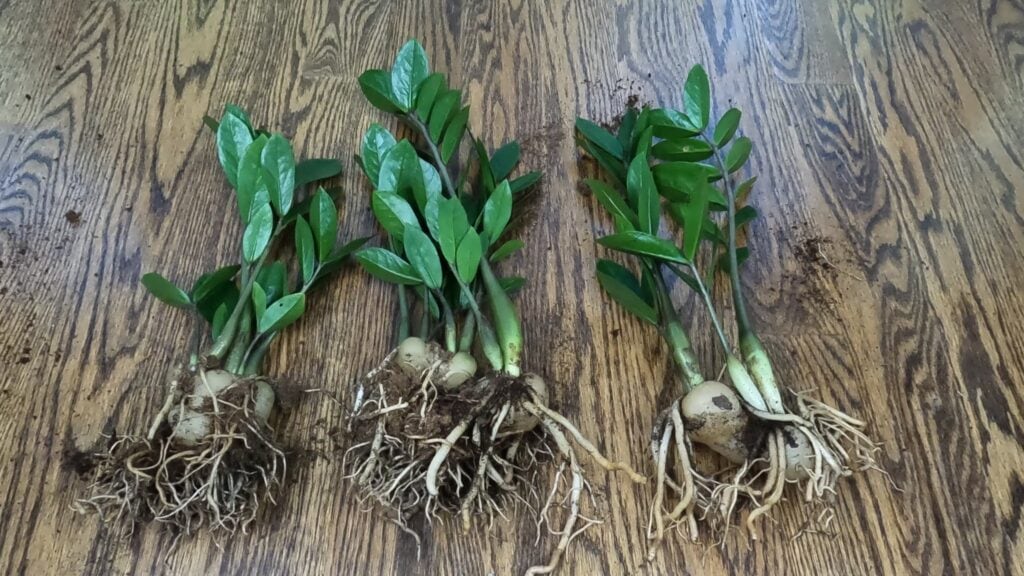
Common Problems of ZZ Plant Care (Zanzibar Gem)
The most common problems that affect ZZ Plants are yellowing leaves and root rot.
Your Zanzibar Gem Looks Wilted
Problem: Even though the soil is damp, your ZZ plant appears wilted. Pull the plant out and examine the roots for signs of root rot. Root rot is evident if the roots of your ZZ plant appear mushy (healthy roots are firm) and the roots are gray to black in color.
Cause: Fungus causes root rot, which is a significant concern for your Zanzibar Gem. Wet soil from overwatering or insufficient drainage causes root rot.
Solution: When your ZZ plant gets root rot, it has a minimal chance of surviving. The best course of action is to remove your ZZ plant and replace it with a new one. Don’t overwater your ZZ plant this time, and make sure the pot has sufficient drainage.
The Leaves of Your ZZ Plant are Turning Yellow
Problem: If the leaves of your Zanzibar Gem start to yellow, it’s a warning that something is up.
Cause: It could be a fungal infection if you notice yellowing leaves with black specks. Nutrient deficit might also be indicated by yellow leaves. Overwatering or hot, afternoon sunlight can also cause yellowing leaves.
Solution: Check to see if your ZZ plant is being overwatered or if it is being placed in direct afternoon sunlight. If this is the case, relocate your ZZ plant and reduce watering. Check for nutrient insufficiency as well; if so, it’s time to fertilize your Zanzibar Gem.
Check out this ZZ Plant Care video
Check out my ZZ Plant Guides
How to Repot ZZ Plant and How to When It’s Time to Repot?
How to Divide ZZ Plant (Zamioculcas zamiifolia video)
How to Take Care of Your ZZ Plant (Zanzibar Gem)- Infographic
What to do with the new ZZ plant that you bring home (Do’s & Don’ts)

